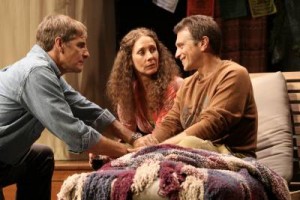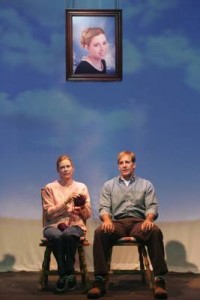
When I see a production as beautifully written, directed, and performed as The
Quality of Life, I thank my lucky stars that I live in Los Angeles (well, in
Alhambra, actually, but who’s splitting hairs?). Where else could I be treated
to internationally known film and TV vets like Scott Bakula, Dennis Boutsikaris,
Laurie Metcalf, and JoBeth Williams returning to their stage roots, an award-
winning writer/director like Jane Anderson with serious film/TV/stage credits,
and a design team as fine as the one assembled at the Geffen for this
production?
The Quality of Life is a beautiful piece of writing, commissioned by the Geffen,
and executed with love and joy and humor and compassion by Anderson,
who believes that in these days of polarization, the only way to come to
understanding people with diametrically opposed views is to spend time with
them, to attempt to walk a mile in their shoes.
Bill and Dinah are “Red Staters,” from Ohio, salt of the earth people grieving
the loss of their teenage daughter to an unfathomably vile and violent crime,
who have turned to their faith to help them live day to day. They use quaint
euphemisms like “for sweet’s sake” uttered in their flat Midwestern inflections,
and try to take comfort that their daughter is “in the arms of her Lord Jesus.”
Dinah’s cousin Jeannette and her husband Neil are “Blue Staters,” from
Northern California, 40something flower children who call each other “Babe”
and favor expressions like “Earth to Jeannette…” When presented with a
praying hands candle, they assume the hands belong to Buddha. “It’s
supposed to be Jesus, but that’s all right,” explains Dinah.
Following a devastating fire which destroyed their home and the land around
it (something which could not be more topical), Jeannette and Neil are now
living in a “yurt,” a kind of tent designed by Mongolian nomads but made in
Seattle, have an outdoor kitchen with running water (if it rains, they just eat
out), and between fire-gutted trees, they have hung objects melted and
mutilated by the fire, along with Chinese lanterns, as ornaments.
After learning that Neil has little time left to live (he is dying from terminal
prostate cancer which has spread through his body) and needing a change of
scene, Dinah convinces Bill that they should pay Jeannette and Neil a visit.
Culture shock begins almost at once for both couples. When Bill suggests with
Midwestern good sense that Jeannette and Neil can always get another cat
to replace their beloved pet lost in the fire, the look of absolute shock on the
Californians’ face speaks volumes about the world of difference between the
two couples. Bill prefers to sit in his car rather than be around Neil when he
smokes (or more accurately) inhales marijuana. “It’s illegal,” is his simple, black
and white explanation.
From the beginning, Dinah is the one (of the four) most willing and able to
empathize. Unlike Bill, she simply exclaims, “Oh, you mean ‘medical
marijuana’” and is even convinced to try it. Unlike her fundamentalist
husband, Dinah is a thinker. She can’t understand a God who would allow his
only Son to suffer and die in agony, or tell Abraham to slit his son Isaac’s throat
and then laugh and say “Just joking!” “I love the Son but I hate the Father,”
she reveals.
Still, she is no more able than her husband to accept Neil’s decision to end his
life with dignity, in two weeks’ time, before the pain becomes too great. Even
harder to understand is Jeannette’s plan, revealed at the end of the first act.
Compare Bill and Jeannette:
Bill: I’m happy that I can find the strength to get up every day.
Jeannette: I would rather leave at my peak than spend the next 30 years with
my lights half dimmed.
Bill: These people are cowards.
Not much room for compromise there.
Still, despite the thousands of miles separating them, physical, cultural, and
moral, and due to the brilliance of Jane Anderson’s writing and her ability to
see deep into the souls of her four characters, each one of them is no longer
the same person when the final curtain falls. The changes may be small, but
they are significant, and we the audience are changed as well.
Each of the four actors is magnificent.
Bakula, his hair plastered down in the most unflattering “do” imaginable, is a
rock of a man, both in strength and in hardness of heart. (“I’m more than glad
that my God has a hell for a twisted soul like his,” is his judgment on Neil’s
suicide plan.) The sophisticated leading man of No Strings so transforms himself
that seeing him walking down the street, one might logically assume that he’d
just stepped off a plane from Grant Wood’s middle America. It’s a tough role,
because he’s the only one of the four who has to hold everything inside, yet
occasionally Bakula allows us to catch a glimpse of the pain within.
Boustikaris’ Neil is about as different from Bakula’s Bill as imaginable—a man
with a heart as big as the acreage he lives on, which he wears proudly on his
sleeve. Though not happy to be leaving this life, he is still able to say, fearlessly,
“I get to design my own end and cherish my last breath.” Boustikaris gives a
rich and wonderful performance as a man who has somehow made his peace
with a far too early end to his life. (My only quibble is that he seems awfully
strong during his final university lecture…for someone so weakened by illness.)
Laurie Metcalf follows her magnificent Ovation winning Kate Keller in last
season’s All My Sons with the wild and wacky Jeannette, and she is simply
fabulous. She gets to wear an outfit any middle-aged hippie would be proud
of, and respond to lines like “Would you like to take Jesus Christ into your
heart?” with a straight-faced, “No thanks, I’m good.” Later, in an
unforgettably funny scene, she teaches Dinah to ululate (at the top of their
voices) as a way to deal with stress. It becomes therefore all the more
powerful to see the quirky free-spirited Jeannette wail in agony at the
impending loss of her partner of 23 years. Just as with Bakula’s Midwestern
farmer, Metcalf, with her long frizzy wig and wigged-out expressions, appears
to have arrived direct from another (and very real) world.
The toughest role, and in my opinion, the finest performance of the bunch is
given by JoBeth Williams. I loved her work in films of the 80s (Kramer vs. Kramer,
The Big Chill, Poltergeist, etc.) and have very much missed her, something I
realized as soon as the lights rose on her and Bakula in their first scene. Several
times during the course of the evening, Williams is called upon to suddenly be
overwhelmed by tears of grief, something we have all experienced in our lives,
but a real challenge for an actor. We sense that beneath her sunny
Midwestern disposition there are layers of pain. “It comes and goes like the
hiccups,” Dinah explains after one of her grief attacks, and we understand
that she has come to accept these moments as part of her life. To see Dinah
get high for the first time in her life is one of the many pleasures of The Quality
of Life, and it allows Dinah the character to reveal things about herself that
even her husband doesn’t know and Williams the actor to let us see beneath
Dinah’s outward calm and resignation. In Dinah, playwright Anderson has
created her richest and most open-minded and open-hearted character, and
Williams does her brilliant justice.
The Quality of Life is a play that’s impossible to categorize. Funny (often
hysterically) it is, but it’s not a comedy per se. Intense and moving it is, but
calling it a drama doesn’t make room for how funny it is. Dramedy trivializes it.
Let’s just say that Jane Anderson has written one heck of a good play, and not
only that, she’s directed her own writing with delicacy and understanding.
This was my first time in the Audrey Skirball Kennis Theater (in its normal
configuration), a “99-seat house” with a proscenium stage seemingly as big as
any “full sized” theater, and it has been filled with a marvelously detailed set
designed by François-Pierre Couture, described in an earlier paragraph. When
we see Christina Haatainen Jones’ costumes, we know immediately what kind
of person each character is. Jason H. Thompson’s lighting makes us feel that
we are indeed outdoors in a burnt to a crisp landscape. Finally Karl Lundeberg’
s original music and sound design combine wind chimes and hymns like What a
Friend We Have in Jesus, to evoke the separate worlds the two couples come
from.
Anderson has said, “I have been so grieved by the rift in our country…, that we
are in combat with our own citizens… I keep wondering if there is any way I
can bridge the gap.” In The Quality of Life, she has indeed bridged the gap,
and quite memorably indeed.
Geffen Playhouse, 10886 Le Conte Avenue, Los Angeles.
www.geffenplayhouse.com
–Steven Stanley
October 23, 2007




 Since 2007, Steven Stanley's StageSceneLA.com has spotlighted the best in Southern California theater via reviews, interviews, and its annual StageSceneLA Scenies.
Since 2007, Steven Stanley's StageSceneLA.com has spotlighted the best in Southern California theater via reviews, interviews, and its annual StageSceneLA Scenies.







 COPYRIGHT 2024 STEVEN STANLEY :: DESIGN BY
COPYRIGHT 2024 STEVEN STANLEY :: DESIGN BY